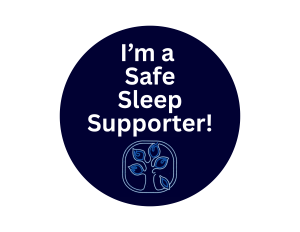
Between social media influencers, books, grandparents’ opinions, friends, and Googling, it can seem like there is a lot of conflicting information about safe sleep. How can you be sure you have the best, up-to-date safe sleep guidance? Here at SIDS of Illinois, we prioritize evidence-based and simple guidelines.
Let’s look at common myths and opinions about safe sleep, and what the latest guidelines say. We’ll help you make the safest choices for your baby to reduce the risk of SIDS and suffocation.
Myth #1: “Babies sleep better on their stomachs.”
Fact: Stomach sleeping increases the risk of SIDS. Babies should always be placed on their backs for every sleep.
When a baby sleeps on their stomach, they are more likely to re-breathe their own exhaled air, which is low in oxygen and high in carbon dioxide. This can lead to a dangerous buildup of CO2 and reduce their ability to wake up if they are in distress, a protective mechanism against SIDS.
Myth #2: “It’s okay to sleep with my baby, because I’m a light sleeper.”
Fact: Bed-sharing increases SIDS risks, regardless of sleep habits. Room-sharing is the safer alternative.
Even a light sleeper can inadvertently roll onto a baby. Babies can also sink deeply in a soft adult mattress, which is unsafe. Also, your baby can become trapped or suffocated by the soft bedding, pillows, and blankets in an adult bed. Room-sharing, not bed-sharing, allows for easier access for feeding and comforting without the dangers of bed-sharing.
Myth #3: “Crib bumpers and pillows make the crib cozy and cuter.”
Fact: Soft bedding, including bumpers, increases suffocation risk. A firm mattress with a fitted sheet is all your baby needs. If they need an additional layer for warmth, a wearable sleep sack will do the trick.
Bumpers and pillows can block a baby's airway if they roll against them. Babies can also get trapped between the bumper and the mattress. In fact, bumpers have been federally banned because of their association with infant death.
The crib should be a bare, firm sleep space for safety.
Myth #4: “If my baby spits up, they could choke if they are on their back.”
Fact: Back sleeping is still safest, even for reflux-prone babies. Healthy babies have natural reflexes to protect their airways.
A baby's anatomy is designed to prevent choking while on their back. If a baby spits up or vomits, gravity naturally helps the fluid flow to the sides of their mouth, not into their windpipe. Their gag reflex also helps clear any fluid.
Myth #5: “A nap in the car seat or swing is fine if the baby is supervised.”
Fact: Sitting devices like car seats, swings, and bouncers are not safe for sleep, even with supervision. Babies can slip downward due to the incline. This shifting allows their airways to collapse.
In an inclined or semi-upright position, a baby's head can flop forward, compressing their airway and making it difficult to breathe. This risk increases the longer they are in the device and can occur even when an adult is present. Sleeping babies should always be moved to a firm, flat sleep surface.
Myth #6: “I heard that weighted sleep sacks or swaddles will help my baby sleep longer.”
Fact: Weighted products are not recommended for infants, since they can reduce mobility and breathing.
The added weight in these products can restrict a baby's movement and ability to shift their position, potentially hindering their ability to breathe freely. The American Academy of Pediatrics and the U.S. Consumer Product Safety Commission advise against their use.
Myth #7: “Cold weather means I should cover my baby with a blanket.”
Fact: Use a wearable sleep sack instead of loose blankets to keep your baby warm and safe. Blankets, quilts, and loose bedding can pose a suffocation hazard to your baby.
Loose blankets can easily cover a baby's face, leading to suffocation or rebreathing of air. Blankets can also become tangled around the baby's neck. Wearable sleep sacks provide warmth without these risks, as they fit around the baby like clothing and cannot cover their head.
Myth #8: “Only new parents need to hear about safe sleep.”
Fact: All caregivers, including grandparents, babysitters, and older siblings, must know and follow safe sleep practices. Guidelines have changed as we have learned more about reducing the risk of SIDS and suffocation.
Safe sleep recommendations have evolved over the years as research has provided new insights into SIDS prevention. What was considered acceptable even a decade or two ago may now be known to be dangerous. Be sure that everyone who cares for the baby knows about the ABCS of Safe Sleep to keep your baby safe: Alone, on their Back, in a Crib, in a Smoke-free environment.
About SIDS of Illinois, Inc.
Sudden Infant Death Services of Illinois, Inc., is a not for profit, 501(c)(3) organization dedicated to the prevention of sudden, unexpected infant death by providing educational programs to families, healthcare professionals, law enforcement, childcare providers, and the general public as well as bereavement services to families and any others who have experienced the tragedy of sudden, unexpected infant death. Donate here to become a Safe Sleep Supporter!
